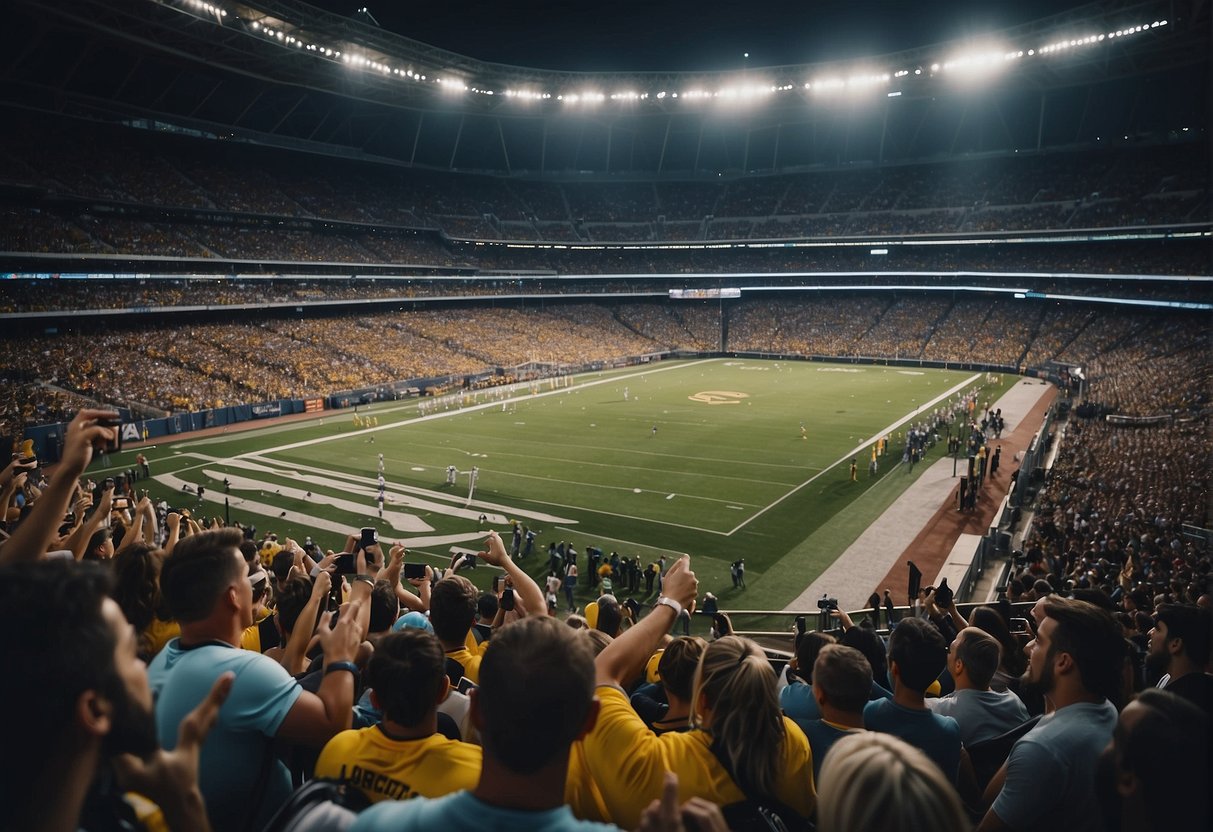Social Media and Fan Engagement in Sports

In addressing the impact of social media on sports, we observe a significant shift in how fans interact with their favorite teams and athletes, with platforms like Facebook, Twitter, and Instagram revolutionizing engagement.
The Role of Social Media in Enhancing Fan Experience
We see that social media platforms have become integral to the sports fan experience. With real-time updates and behind-the-scenes content, fans have unprecedented access to their favorite teams and athletes. For instance, platforms enable fans to view live game snippets, participate in polls, and engage in game-related discussions, thus enhancing their overall experience.
- Real-time Updates: Fans receive live scores and in-game highlights, which captivate their attention and foster a sense of inclusion.
- Behind-the-Scenes Content: Exclusive content such as locker room speeches and player interviews add value and depth to fan engagement.
Furthermore, special features like Instagram Stories or Twitter Moments serve as innovative ways to present game narratives, allowing fans to follow the action as it happens. The instant nature of these updates ensures fans are constantly engaged, nurturing their connection to the sport.
Evaluating Fan Engagement: Metrics and Methods
To thoroughly evaluate fan engagement, we refer to specific metrics and methods that provide insights into how effectively sports entities captivate their audiences on social media. Engagement rate and impressions stand out as key indicators of fan interaction and reach.
- Engagement Rate: This metric typically measures the level of interaction—likes, comments, shares—relative to the number of followers, providing insight into how compelling the content is.
- Impressions: The total number of times content is displayed, regardless of clicks, allows us to gauge the reach and potential impact of social media activity.
We leverage analytics tools provided by the social media platforms themselves or third-party software, enabling us to quantify engagement and understand fan behavior better. This data-driven approach guides sports speakers and marketers in crafting effective strategies for fan outreach and involvement.
Influence of Athlete Social Media Presence on Public Perception

We understand that in today’s digital world, an athlete’s presence on social media platforms such as Instagram has become an integral part of how they are perceived publicly. Effective branding and personalized content can significantly enhance an athlete's brand equity and cultivate a strong sense of loyalty among fans.
Athlete Branding and Social Media Strategy
We recognize that social media offers athletes an unparalleled opportunity to build and control their personal brand. Athlete branding on platforms like Instagram involves a strategic blend of content that often highlights their professional achievements, personal life, and behind-the-scenes insights, which contributes to a more personable and relatable image. This personalization of content not only boosts their brand equity but also fosters a deeper connection with their audience.
- Content Mix: Sharing a variety of posts, from training sessions to personal milestones.
- Engagement: Regular interaction with followers through comments and direct messages.
- Consistency: Maintaining a consistent posting schedule to keep the audience engaged.
Impact of Athlete-Generated Content on Fan Loyalty
Our analysis indicates that the content generated by athletes on their social media platforms can significantly influence fan loyalty. Content that fans perceive as authentic and relatable often strengthens their emotional investment in the athlete. By providing exclusive content that is not available through traditional media channels, athletes can enhance their fans' sense of belonging and loyalty.
- Exclusive Insights: Behind-the-scenes looks at the athlete's lifestyle and training.
- Relatable Stories: Personal stories and challenges that humanize the athlete.
- Interaction: Personalized responses and acknowledgment of fan support.
By strategically leveraging their social media presence, athletes can effectively shape public perception and cultivate a loyal fanbase.
Sports Organizations' Use of Social Media for Marketing
In this section, we explore how sports organizations harness social media for marketing efforts, establishing stronger bonds with fans and securing lucrative sponsorship deals.
Relationship Marketing through Social Media Platforms
We recognize the dynamic power of social media platforms in facilitating relationship marketing. Sports teams and leagues use networks like Twitter, Facebook, and Instagram to create a sense of community among fans, fostering engagement through regular updates and interactive content. By sharing behind-the-scenes looks and player insights, we build loyalty and encourage fans to become active participants in our sports narrative.
- Engagement: Through polls, live-tweeting events, and Q&A sessions, we increase fan interaction and investment.
- Direct Communication: Our ability to communicate directly with our audience helps in personalizing the fan experience.
Sponsorship and Advertising in the Age of Digital Media
We've observed that social media amplifies the visibility of sponsors and advertisers associated with sports organizations. Platforms serve as a broadcast medium for brands to reach wider audiences through association with our teams and players.
- Brands: They leverage our social media presence for targeted campaigns, capitalizing on our reach and fan demographics.
- Public Relations and Sports Journalism: Exclusive content and stories are distributed on social media, creating a symbiotic relationship between media and our sports teams for mutual growth.
The Role of Social Media in Sports Communication and Management
In sports communication and management, social media plays a pivotal role in shaping perceptions and engaging with various stakeholders. We explore its profound impact on media coverage and strategies sport entities utilize for optimal social media management.
Effect of Social Media on Sports Media Coverage
Social media has transformed the landscape of sports media coverage. Traditional outlets are no longer the sole source of information; fans now turn to platforms like Twitter and Instagram for real-time updates from football clubs and coaches. With social media research highlighting increased fan engagement, clubs curate their content to maintain relevance and connection with their audience.
- Curation: Careful content selection ensures relevant information reaches fans.
- Monitoring: Continuous tracking of social media allows for prompt responses to emerging trends.
This immediate and often personalized coverage creates a more dynamic and interactive media environment in the sport industry.
Social Media Management Strategies for Sport Entities
Effective social media management is critical for any sport entity looking to maximize its online presence. We've seen public relations teams within sports integrate social media as key components of overall strategy. Here's how they're successfully navigating the online space:
- Engagement: Developing content plans that encourage interaction and foster a strong community.
- Consistency: Maintaining a steady, recognisable voice across all channels to build trust and loyalty.
Strategies also include identifying the appropriate platforms for different stakeholders, using analytics for targeted campaigns, and ensuring a unified message is conveyed across all digital touchpoints.
Academic Perspectives on Social Media in Sports
In this section, we explore the significant academic insights into how social media interfaces with the sports industry. Our focus narrows on the contours of scholarly research and the prevailing research trends.
Literature Review on Social Media's Impact in Sports
Literature reviews serve as a cornerstone for synthesizing existing research within sports and social media scholarship. A systematic review of articles from prominent publications, such as the International Journal of Sport Communication and Sport Management Review, provides a multidimensional understanding of social media's role. For instance, datasets extracted from Web of Science and Scopus indicate a positive correlation between social media engagement and athlete and team branding efficacy.
- Themes Identified: The reviews consistently note that social media platforms facilitate a dynamic where athletes establish direct communications with fans, influencing public perception and engagement.
- Theoretical Frameworks: Various theories have been applied, positioning social media as a tool for community building and identity negotiation within the sports context.
Emerging Trends in Social Media and Sport Studies Research
Research in sports-related social media is continually evolving. New studies highlight the importance of social media in shaping discussions and narratives within sports. These emerging trends are becoming a staple in social media scholarship, particularly noticed in recent volumes of the International Journal of Sport Communication.
- Geo-Social Analysis: Researchers highlight how social media transcends international borders, fostering global sports communities.
- Big Data and Analytics: The use of datasets for analyzing engagement patterns is growing, enabling deeper insights into fan behavior on social platforms.

